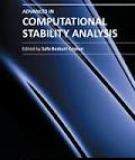Tài liệu Thư viện số
- Tài liệu tổng quát (1048 )
- Triết học & Tâm lý học (1067 )
- Khoa học xã hội (1212 )
- Ngôn ngữ (765 )
- Khoa học tự nhiên (850 )
- Khoa học ứng dụng (1648 )
- Nghệ thuật (820 )
- Văn học (1020 )
- Lịch sử & Địa lý (811 )
- Địa chí tỉnh BR-VT (119 )
Danh mục TaiLieu.VN
- Mẫu Slide Powerpoint
- Luận Văn - Báo Cáo (344720)
- Kinh Doanh Marketing (65512)
- Kinh Tế - Quản Lý (48934)
- Tài Chính - Ngân Hàng (55898)
- Công Nghệ Thông Tin (142209)
- Tiếng Anh - Ngoại Ngữ (47066)
- Kỹ Thuật - Công Nghệ (134345)
- Khoa Học Tự Nhiên (107174)
- Khoa Học Xã Hội (82451)
- Văn Hoá - Nghệ Thuật (54408)
- Y Tế - Sức Khoẻ (173915)
- Nông - Lâm - Ngư (62504)
- Kỹ Năng Mềm (29016)
- Biểu Mẫu - Văn Bản (27610)
- Giải Trí - Thư Giãn (51994)
- Văn Bản Luật (198854)
- Tài Liệu Phổ Thông (402015)
- Trắc Nghiệm Online (213578)
- Trắc Nghiệm MBTI
- Trắc Nghiệm Holland
ADVANCES IN COMPUTATIONAL STABILITY ANALYSIS
Currently, imperfection sensitive shell structures prone to buckling are designed according
the NASA SP 8007 guideline using the conservative lower bound curve. This guideline dates
from 1968, and the structural behaviour of composite material is not appropriately
considered, in particular since the imperfection sensitivity and the buckling load of shells
made of such materials depend on the lay-up design. This is not considered in the NASA SP
8007, which allows designing only so called "black metal" structures. There is a high need
for a new precise and fast design approach for imperfection sensitive composite structures
which allows significant reduction of structural weight and design cost. For that purpose a
combined methodology from the Single Perturbation Load Approach (SPLA) and a specific
stochastic approach is proposed which guarantees an effective and robust design. The SPLA
is based on the observation, that a large enough disturbing load leads to the worst
imperfection; it deals with the traditional (geometric and loading) imperfections [1]. The
stochastic approach considers the non-traditional ones, e.g. variations of wall thickness and
stiffness. Thus the combined approach copes with both types of imperfections. A recent
investigation demonstrated, that applying this methodology to an axially loaded unstiffened
cylinder is leading directly to the design buckling load 45% higher compared with the
respective NASA SP 8007 design [2].
the NASA SP 8007 guideline using the conservative lower bound curve. This guideline dates
from 1968, and the structural behaviour of composite material is not appropriately
considered, in particular since the imperfection sensitivity and the buckling load of shells
made of such materials depend on the lay-up design. This is not considered in the NASA SP
8007, which allows designing only so called "black metal" structures. There is a high need
for a new precise and fast design approach for imperfection sensitive composite structures
which allows significant reduction of structural weight and design cost. For that purpose a
combined methodology from the Single Perturbation Load Approach (SPLA) and a specific
stochastic approach is proposed which guarantees an effective and robust design. The SPLA
is based on the observation, that a large enough disturbing load leads to the worst
imperfection; it deals with the traditional (geometric and loading) imperfections [1]. The
stochastic approach considers the non-traditional ones, e.g. variations of wall thickness and
stiffness. Thus the combined approach copes with both types of imperfections. A recent
investigation demonstrated, that applying this methodology to an axially loaded unstiffened
cylinder is leading directly to the design buckling load 45% higher compared with the
respective NASA SP 8007 design [2].
Từ khóa: Functionally Graded, Composite Structures, Stability, Dynamic, Aeroelastic Optimization
140 p tailieu_thuvienbrvt 25/11/2012 215 2


